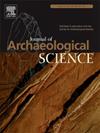阿拉伯天青石文物的首个来源证据:对阿曼苏丹达瓦乌姆安-纳尔墓DH7-1中珠子的分析研究
IF 2.5
1区 地球科学
Q1 ANTHROPOLOGY
引用次数: 0
摘要
在这项工作中,通过非侵入式分析技术分析了在达瓦(公元前2500-2000年,阿曼苏丹国)发掘的乌姆安纳尔型公共墓中发现的两颗保存完好的青金石珠子,试图确定其原材料的来源。这些珠子的重要性在于,它们可能是迄今为止在阿拉伯东南部发现的最早的青金石物品之一。在这项工作中提出的来源和风格调查的综合结果旨在评估用于生产这些珠子的原材料的地质来源以及它们的文化联系,为重建公元前第三千年西亚和地中海之间的青金石贸易提供重要的见解。为了鉴定青金石的物源,采用空气离子微束技术测定了青金石岩石中不同矿物学相的微量元素含量和发光性质。这些数据与过去15年从智利、阿富汗、西伯利亚、塔吉克斯坦和缅甸五个矿区收集的岩石数据进行了比较。使用基于该岩石数据库的协议并利用成分结果的多元方法(主成分分析),有可能证明珠子的原材料仅与阿富汗采石场地区相匹配。本文章由计算机程序翻译,如有差异,请以英文原文为准。
First provenance evidence for lapis lazuli artefacts from Arabia: Analytical study of beads from the Umm an-Nar tomb DH7-1 at Dahwa, Sultanate of Oman
In this work, two wholly preserved lapis lazuli beads from an Umm An-Nar-type communal tomb excavated in Dahwa (2500-2000 BCE, Sultanate of Oman) have been analysed by means of non-invasive analytical techniques to try to determine the provenance of their raw material. The importance of these beads is due to the fact that they are possibly among the earliest lapis lazuli objects found in south-eastern Arabia to date. The combined results of the provenance and stylistic investigations presented in this work aim to assess the geological origin of the raw material used to produce these beads as well as their cultural affiliation, providing crucial insights into reconstructing the lapis lazuli trade between Western Asia and the Mediterranean during the third millennium BCE. To identify the lapis lazuli provenance, in-air ion microbeam techniques were used to measure the trace elements content and the luminescent properties of different mineralogical phases within the lapis lazuli rock. Data were compared with those collected over the past 15 years on rocks from five mining areas in Chile, Afghanistan, Siberia, Tajikistan and Myanmar. Using a protocol based on this rock database and exploiting a multivariate method (principal component analysis) on the compositional results, it was possible to prove that the raw material of the beads only matched the Afghan quarry district.
求助全文
通过发布文献求助,成功后即可免费获取论文全文。
去求助
来源期刊

Journal of Archaeological Science
地学-地球科学综合
CiteScore
6.10
自引率
7.10%
发文量
112
审稿时长
49 days
期刊介绍:
The Journal of Archaeological Science is aimed at archaeologists and scientists with particular interests in advancing the development and application of scientific techniques and methodologies to all areas of archaeology. This established monthly journal publishes focus articles, original research papers and major review articles, of wide archaeological significance. The journal provides an international forum for archaeologists and scientists from widely different scientific backgrounds who share a common interest in developing and applying scientific methods to inform major debates through improving the quality and reliability of scientific information derived from archaeological research.
 求助内容:
求助内容: 应助结果提醒方式:
应助结果提醒方式:


